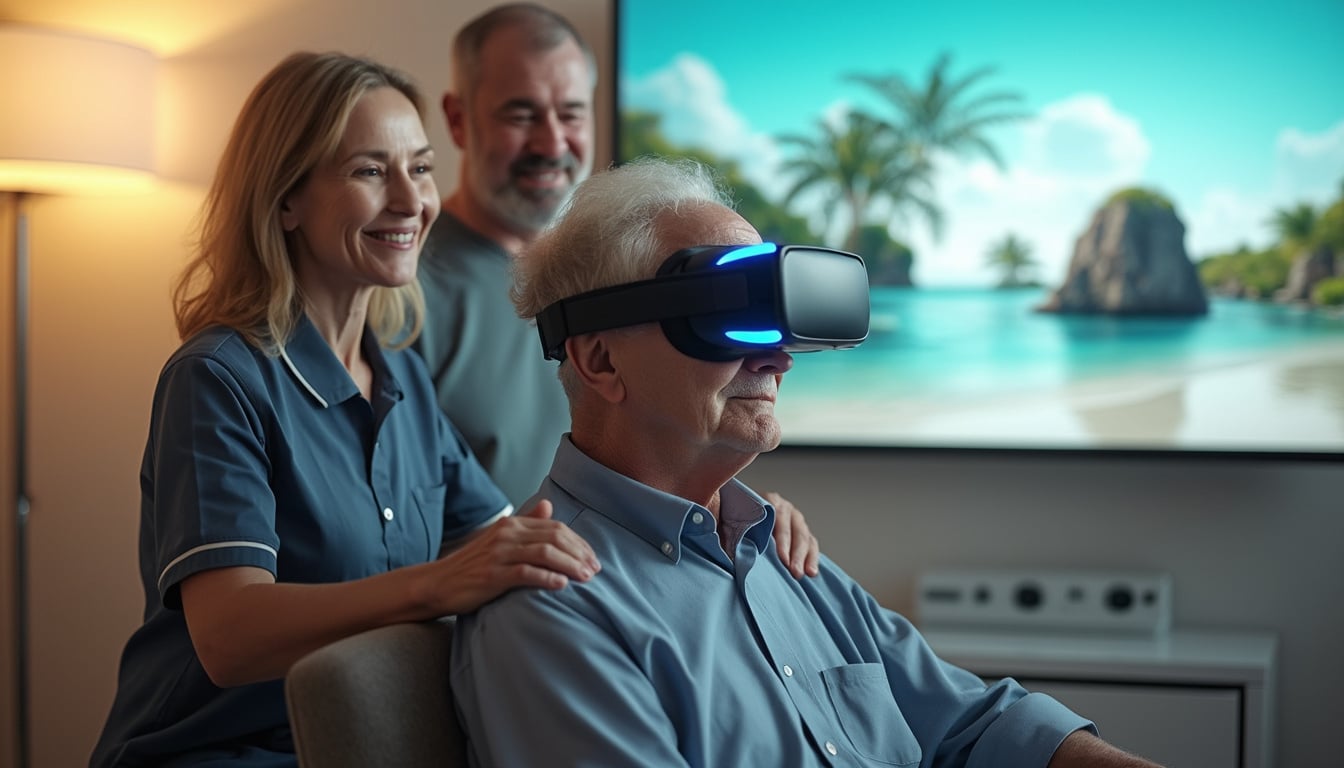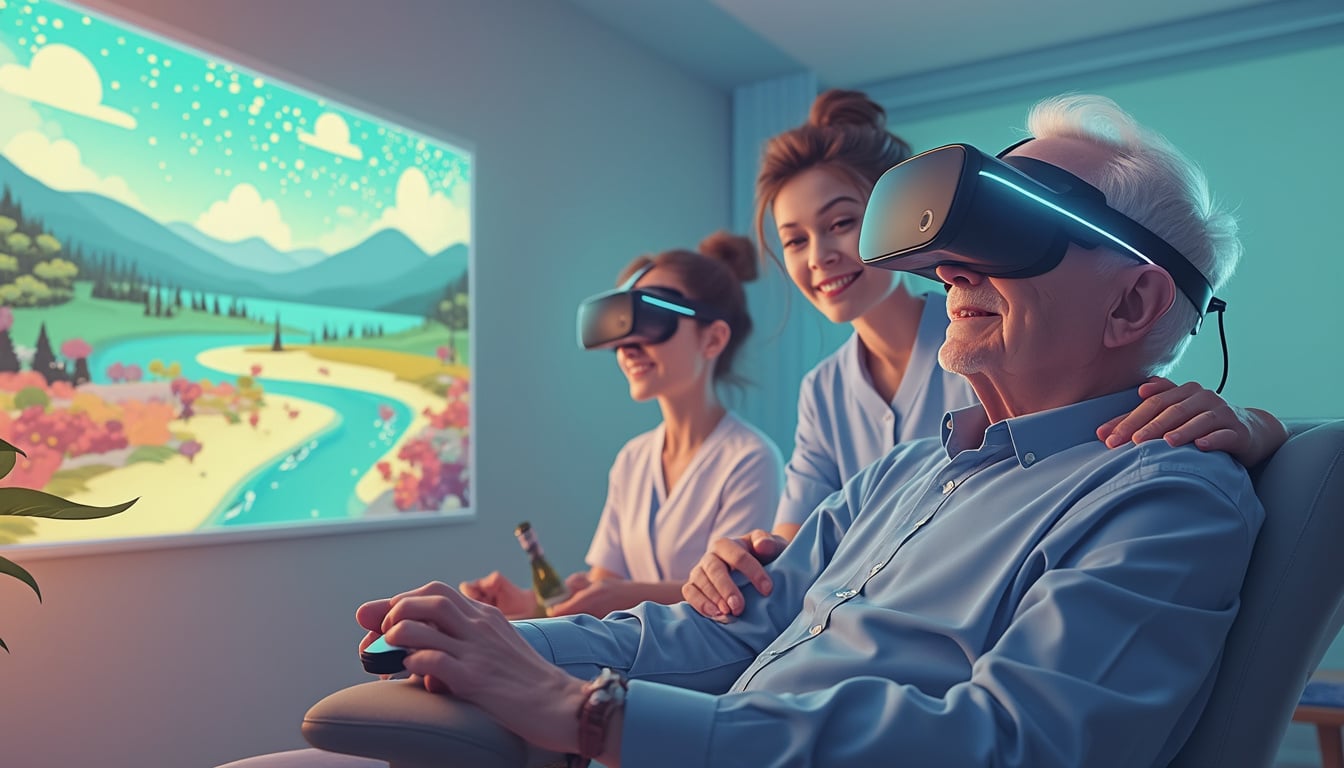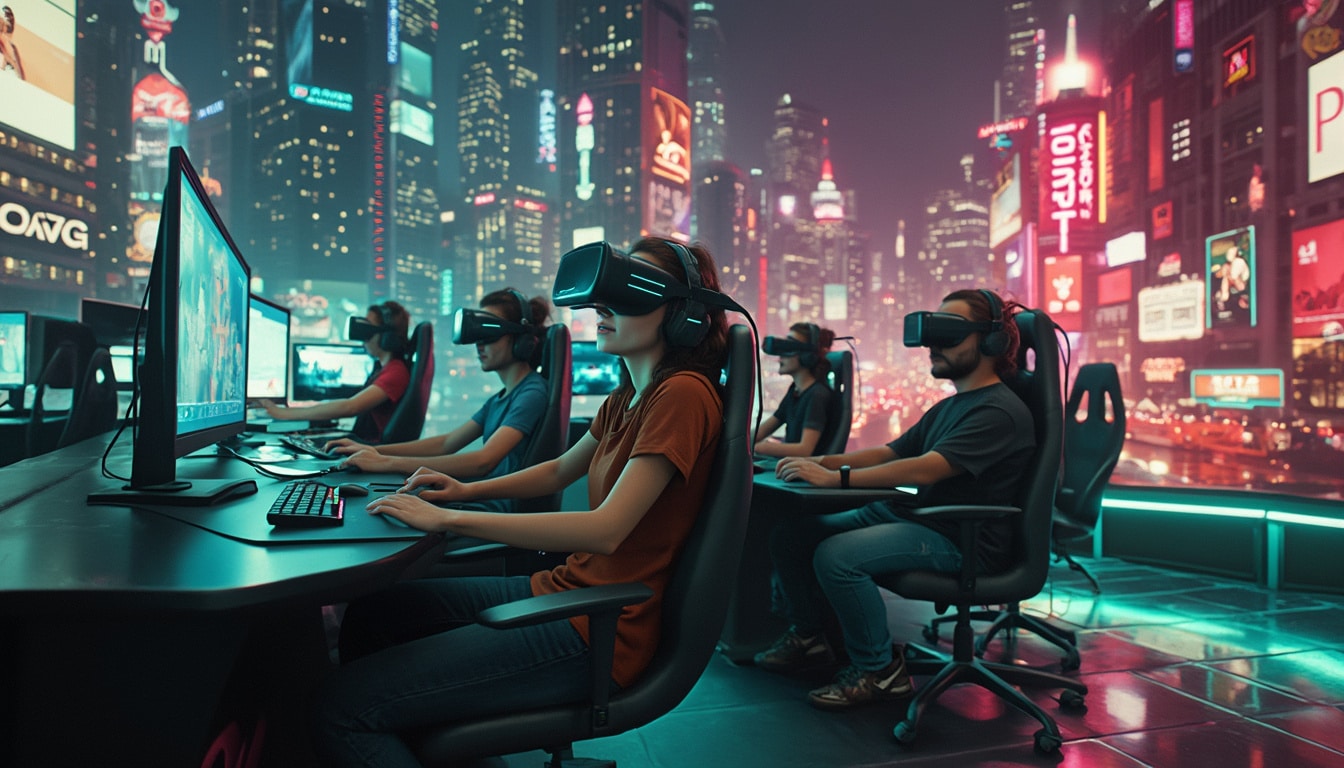Think virtual reality is just for gamers and escapades? Think again! VR headsets are stepping into the realm of healthcare. They’re not just opening doors to new worlds, but also to new diagnostic possibilities.
Imagine putting on your VR glasses not to battle dragons, but to help detect Alzheimer’s early. It might sound like something out of a sci-fi novel, but researchers are making it a reality. In France alone, the numbers are staggering, with over 1.2 million people affected by Alzheimer’s in 2024. Each year, about 225,000 new cases are diagnosed, making early detection crucial. Traditional tests can be pricey and uncomfortable, often requiring visible signs before they can even hint at the disease. Enter virtual reality: a fun, needle-free alternative that could revolutionize how we identify memory issues. By navigating virtual spaces, users might unknowingly reveal vital clues about their cognitive health.
The challenge with current Alzheimer’s tests is that they’re not exactly enjoyable or cost-effective. They often rely on noticeable symptoms before raising any red flags. However, VR is changing the landscape with simpler, more engaging assessments. According to a study from Stanford, virtual reality can detect early memory problems by asking participants to find objects in a simulated living room. As age or cognitive issues progress, the ability to recall object locations diminishes. This isn’t just about tired neurons; there’s a link between VR performance and specific proteins associated with Alzheimer’s risk. So, if you struggle to locate your VR glasses in a virtual room, it might say more about your brain than you think.
Neuroscientist Tammy Tran emphasizes that our memories shape who we are. With VR, we can better understand the onset of Alzheimer’s and potentially intervene sooner. Plus, participants actually have fun while contributing to scientific breakthroughs. Madhav, a robot and brain enthusiast, took this idea further by designing virtual mazes to study orientation skills among different age groups. His team managed to keep participants engaged in VR for over an hour without too much motion sickness or confusion. Early results indicate that age influences navigation and memory in virtual environments, offering hope for distinguishing early Alzheimer’s symptoms. Soon, they plan to include individuals already diagnosed to compare results.
Madhav believes VR heralds a new era for exploring memory, perception, and other brain mysteries. As VR headsets become more accessible, more researchers are likely to dive into this promising field. The intersection of technology and neuroscience is not only paving the way for better diagnostic tools but also making the process enjoyable for those involved. So next time you strap on a VR headset, know that you might be part of a groundbreaking study that’s helping to fight Alzheimer’s one virtual adventure at a time.

Table of contents
Togglethe role of virtual reality in early alzheimer’s detection
Virtual reality (VR) is no longer confined to the realms of gaming and entertainment. In the fight against Alzheimer’s disease, VR is emerging as a revolutionary tool for early detection and diagnosis. Traditional methods of diagnosing Alzheimer’s often rely on invasive procedures and can be both costly and uncomfortable for patients. However, recent advancements have shown that VR can provide a more engaging and effective means of identifying cognitive impairments before they become severe.
Researchers at Stanford University have pioneered the use of VR environments to assess memory and spatial navigation, key areas that are typically affected in the early stages of Alzheimer’s. In their study, participants were asked to navigate through a virtual living room to find specific objects. This seemingly simple task can reveal significant insights into an individual’s cognitive health. Individuals at risk of Alzheimer’s tend to struggle with memory recall and spatial orientation, and these deficits become more pronounced as the disease progresses.
The beauty of using VR lies in its ability to create controlled yet dynamic environments where subtle cognitive deficits can be detected. Unlike traditional tests that may induce anxiety or discomfort, VR-based assessments are immersive and engaging, making the testing process more pleasant for participants. Additionally, VR technology can track a myriad of data points, from the speed and accuracy of object retrieval to eye movements and response times, providing a comprehensive picture of an individual’s cognitive function.
Moreover, the integration of VR in Alzheimer’s detection is supported by the identification of specific biomarkers associated with the disease. Studies have found a correlation between performance in VR tasks and the presence of certain proteins linked to Alzheimer’s risk. This suggests that difficulties in navigating virtual spaces may be indicative of underlying neurodegenerative processes. By leveraging VR, healthcare professionals can pinpoint individuals who may benefit from early interventions, ultimately improving the quality of life for those affected by Alzheimer’s.
For those interested in exploring the broader applications of virtual reality, consider reading about the latest VR boxing games here.
advantages of vr-based testing over traditional methods
When it comes to diagnosing Alzheimer’s disease, early detection is crucial for managing the progression and improving patient outcomes. Traditional diagnostic methods, such as cognitive screenings and neuroimaging, have their limitations. They can be expensive, invasive, and often require the patient to exhibit clear symptoms before a diagnosis is made. In contrast, VR-based testing offers a non-invasive, cost-effective, and more engaging alternative that can identify cognitive impairments at an earlier stage.
One of the primary advantages of VR-based testing is its ability to simulate real-life scenarios in a controlled environment. This allows for the assessment of cognitive functions such as memory, attention, and spatial awareness in a way that is both realistic and standardized. Unlike paper-based tests, VR can adapt the difficulty level in real-time based on the participant’s performance, providing a more nuanced evaluation of their cognitive abilities.
Additionally, VR tests are less reliant on patient cooperation and verbal communication, which can be beneficial for individuals who may be anxious or less communicative. The immersive nature of VR can also reduce the stress and discomfort often associated with traditional testing methods. Participants are more likely to engage fully with the tasks, leading to more accurate and reliable results.
Moreover, VR technology can significantly reduce the time and resources required for testing. Traditional neuroimaging techniques, such as MRI or PET scans, are not only expensive but also require specialized equipment and facilities. VR-based assessments, on the other hand, can be conducted using relatively affordable hardware and software, making cognitive testing more accessible to a broader population. This scalability is particularly important in regions with limited access to advanced medical facilities.
The integration of VR in Alzheimer’s research also opens up new avenues for longitudinal studies. By regularly monitoring cognitive performance in a virtual setting, researchers can track the progression of cognitive decline over time with greater precision. This continuous monitoring can lead to the development of personalized treatment plans and interventions tailored to the specific needs of each patient.
For those interested in the latest trends in VR technology, explore how the Apple Vision Pro is set to introduce stunning VR experiences here.
the science behind vr and cognitive function assessment
Understanding the intricate relationship between virtual reality and cognitive function is essential to appreciating its potential in diagnosing Alzheimer’s disease. At the heart of this technology is the ability to create immersive environments that simulate real-world challenges, thereby engaging multiple cognitive processes simultaneously. This multifaceted engagement provides a comprehensive assessment of an individual’s cognitive health, beyond what traditional tests can offer.
The foundation of VR-based cognitive assessment lies in its ability to measure executive functions, memory, attention, and spatial navigation—all of which are critical areas affected by Alzheimer’s. Executive functions, including problem-solving, planning, and multitasking, can be evaluated through complex VR tasks that require participants to make decisions, remember instructions, and adapt to changing environments. These tasks mimic the challenges individuals face in daily life, providing a realistic measure of their cognitive abilities.
Memory assessment in VR involves tasks that require participants to recall information, such as the locations of objects within a virtual space or sequences of events. This active recall process engages the hippocampus, a region of the brain that is among the first to be affected in Alzheimer’s disease. By observing how participants navigate and remember virtual environments, researchers can identify early signs of memory impairment.
Attention and concentration are assessed through tasks that require sustained focus and the ability to filter out distractions within the virtual environment. These assessments can reveal deficits in information processing speed and attentional control, which are common in individuals with Alzheimer’s. The ability to concentrate on specific tasks while ignoring irrelevant stimuli is a key indicator of cognitive health, and VR provides a dynamic platform to measure these capabilities accurately.
Moreover, VR allows for the collection of detailed data on participants’ interactions within the virtual space. Metrics such as movement patterns, response times, and error rates provide valuable insights into cognitive performance. Advanced analytics can further process this data to identify subtle patterns that may indicate the onset of Alzheimer’s, even before significant symptoms manifest.
Neuroscientists like Tammy Tran emphasize the importance of these technological advancements. According to Tran, « These virtual environments allow us to dissect the cognitive processes involved in memory and spatial navigation in ways that were previously impossible. By understanding how these functions deteriorate, we can develop targeted interventions to slow the progression of Alzheimer’s. »
The integration of VR in cognitive assessment represents a significant leap forward in Alzheimer’s research, offering a more precise and engaging method to evaluate cognitive health. As technology continues to evolve, the potential applications of VR in medical diagnostics and treatment will likely expand, providing even more sophisticated tools to combat this debilitating disease.
innovative vr projects tackling alzheimer’s
The intersection of virtual reality and Alzheimer’s research has given rise to a number of innovative projects aimed at enhancing our understanding and management of the disease. One such pioneering effort is led by Madhav, a researcher passionate about both robotics and the human brain. His groundbreaking work focuses on utilizing VR to unravel the complexities of Alzheimer’s and develop effective strategies for early intervention.
Madhav’s approach involves immersing participants in virtual labyrinths that simulate real-world navigation challenges. By monitoring how individuals navigate these virtual spaces, his team can assess their spatial memory and problem-solving abilities. The premise is simple yet profound: if a person struggles to remember the location of objects or becomes disoriented within the virtual environment, it may indicate early cognitive decline associated with Alzheimer’s.
One of the significant achievements of Madhav’s project is the ability to keep participants engaged in the virtual world for extended periods without causing discomfort or confusion. This is critical, as prolonged exposure allows for a more thorough assessment of cognitive functions over time. The participants, ranging from young adults to the elderly, navigate the virtual labyrinth while researchers collect and analyze data on their performance.
Initial findings from these tests have been promising. Age appears to play a significant role in navigation and memory within the virtual space, with older participants showing more pronounced difficulties. These observations align with the known progression of Alzheimer’s, where cognitive functions deteriorate with age. By identifying these early signs, Madhav’s team aims to develop VR-based screening tools that can be easily administered in various settings, from clinics to community centers.
Future plans for the project include expanding the participant pool to include individuals diagnosed with Alzheimer’s. This will allow for a direct comparison between those at risk and those already affected by the disease. Such comparative studies are essential for validating the effectiveness of VR-based assessments and refining the protocols to enhance their accuracy and reliability.
Madhav believes that VR technology is at the forefront of a new era in cognitive research. « Virtual reality offers an unparalleled opportunity to study the intricacies of the human brain in a controlled yet naturalistic setting, » he explains. « As VR becomes more accessible and user-friendly, we anticipate a surge in research initiatives leveraging this technology to combat not only Alzheimer’s but a range of cognitive disorders. »
Projects like Madhav’s highlight the transformative potential of VR in medical research, demonstrating how innovative technology can bridge the gap between theoretical knowledge and practical application. As VR continues to evolve, its role in Alzheimer’s research is set to become even more integral, paving the way for breakthroughs that could change the landscape of cognitive health.
For insights into selecting the right computer for an immersive VR experience, check out this guide here.
future prospects: vr technology and alzheimer’s research
Looking ahead, the future of virtual reality in Alzheimer’s research appears remarkably promising. As VR technology continues to advance, its applications in medical diagnostics and therapeutic interventions are expected to expand, offering new avenues for combating this pervasive disease. The ongoing integration of VR with other emerging technologies, such as artificial intelligence and machine learning, will further enhance its capabilities, making it an indispensable tool in the fight against Alzheimer’s.
One of the key prospects for VR in Alzheimer’s research is the development of personalized cognitive training programs. These programs can be tailored to the specific needs and cognitive profiles of individuals, providing targeted exercises designed to strengthen memory, attention, and problem-solving skills. By continuously adapting to the user’s performance, these VR-based interventions can offer a dynamic and engaging way to slow cognitive decline, potentially extending the period before more severe symptoms emerge.
Moreover, VR technology has the potential to facilitate remote monitoring and telehealth services, making cognitive assessments and interventions more accessible to individuals in different geographical locations. This is particularly important given the increasing prevalence of Alzheimer’s and the strain it places on healthcare systems worldwide. By leveraging VR, healthcare providers can conduct evaluations and deliver therapies without the need for physical appointments, reducing barriers to care and ensuring timely support for those in need.
The collaboration between VR developers and neuroscientists is also expected to yield more sophisticated diagnostic tools. As our understanding of the neural underpinnings of Alzheimer’s deepens, VR environments can be designed to probe specific cognitive domains and neural networks. This precision will enable more accurate and early detection of the disease, facilitating prompt interventions that can significantly improve patient outcomes.
Furthermore, the accessibility and affordability of VR hardware are set to improve, driven by advancements in technology and increased consumer demand. Innovations like the Apple Vision Pro and other cutting-edge VR headsets are making immersive experiences more reachable for both researchers and the general public. This democratization of VR technology will accelerate its adoption in Alzheimer’s research, fostering a collaborative environment where more studies can be conducted, and data can be shared widely.
As VR continues to evolve, its role in Alzheimer’s research will likely extend beyond diagnostics and interventions. It may also become a vital tool for enhancing the quality of life for patients and their caregivers. Virtual environments can provide cognitive stimulation, social interaction, and recreational activities that help mitigate the emotional and psychological impacts of Alzheimer’s. By offering a blend of therapeutic and supportive functions, VR can contribute to a holistic approach to managing the disease.
In conclusion, the intersection of virtual reality and Alzheimer’s research holds immense potential for transforming how we understand, diagnose, and treat this debilitating condition. With ongoing advancements and collaborative efforts, VR is poised to become a cornerstone in the fight against Alzheimer’s, bringing hope to millions affected by the disease worldwide.
For updates on the availability of premium VR headsets like Quest Pro, visit this link.














